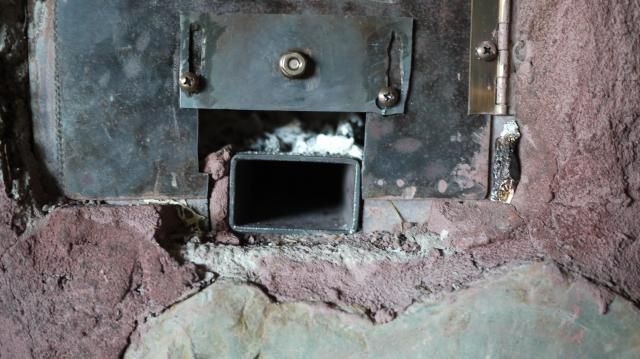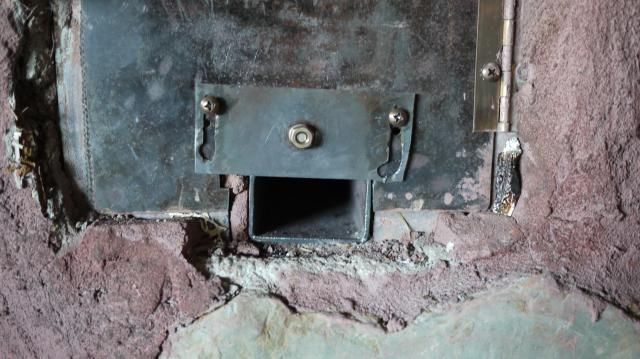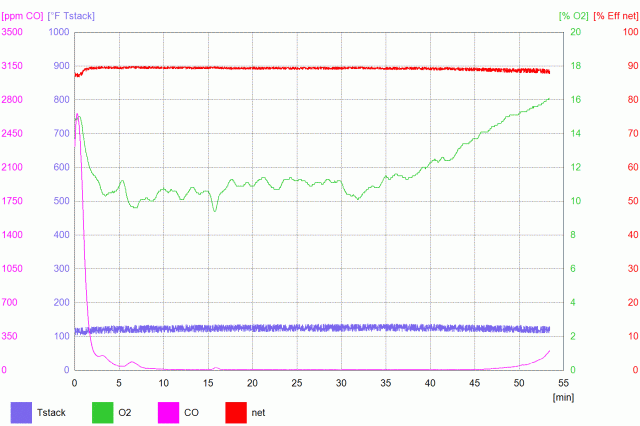|
|
Post by matthewwalker on Nov 22, 2014 15:27:20 GMT -8
Terry, port is 9" tall. Back wall is flat, or parallel to the door. 19.75" from door frame to back wall. It's okay to have an extra 1/4"-1/2" length for the secondary inlet to extend past the poorly fitting door. Okay, so my awesome neighbor brought me more of the 2.25" x 1.25" I.D. tubing last night. I just finished making v5. Peter, as per your recommendation the vertical tube is 2" I.D. for 3.14"sq. csa. Slot is now 6" x 3/8" for 2.25"sq. csa. No top cap, some holes down low from crappy fab work using found scraps. Inlet csa is 2.8"sq., so outlet side of v5 is more all told with the open top and leaks down low. v5 next to v4...  And here's the crappy door. It has sorta evolved, and is giving me ideas on what a door for this stove might be like, but for now, this one is good for testing different settings. Primary open...  Primary closed...  |
|
|
|
Post by matthewwalker on Nov 22, 2014 22:25:02 GMT -8
Peter, your sizing recommendations were right on. v5 is very nice, stable and predictable.  |
|
|
|
Post by Donkey on Nov 23, 2014 0:56:01 GMT -8
One possible improvement here is that velocity in the fuel bed is lower than normal, there's likely to be less particulate (fine ash) in the exhaust stream.
|
|
|
|
Post by peterberg on Nov 23, 2014 2:20:17 GMT -8
Peter, your sizing recommendations were right on. v5 is very nice, stable and predictable. Yes!!! The diagram is very nice indeed, predictability is also highly regarded in heater development. The O2 is at the same level as before so I'm inclined to think the secundary supply is still too large. Maybe you could stuff the top and the bottom holes with superwool? When that doesn't yield the right effect then it's time to restrict the inlet side of things slightly in order to see what's happening. Don't worry about the supply too much, cold air entering the rectangle tube is expanding 4 times going from 68 F to 1800 F. The moist in that same air is expanding 1500 times. So in the cold end the air is moving relatively slow which is good for heating up. Keeping that 4 times expansion in mind, the inlet could be as tiny as 1/4 of the csa and still drawing enough air. Now what is the distance from the vertical tube to the port? I would say enough to leave half the size of the port csa open left and right. That round tube is just the right shape to lead the combustible gases to the port. Now I come to think about it: should we regard the port as the tightest entrance or the back gaps between tube and back wall? And Donkey is right, almost no primary air leads to less movement through the ash bed. All stove manufacturers are moving on this road, that has been the visable course last year in Washington I'd think. |
|
Deleted
Deleted Member
Posts: 0
|
Post by Deleted on Nov 23, 2014 2:43:05 GMT -8
The moist in the cold air has already undergone phase change
and thus will not expand more than the air.
|
|
|
|
Post by peterberg on Nov 23, 2014 2:49:02 GMT -8
The moist in the cold air has already undergone phase change and thus will not expand more than the air. Yes, you are right, my mistake. |
|
|
|
Post by grizbach on Nov 23, 2014 9:22:31 GMT -8
Matt,
I agree with Peter, Try it with those leaks closed up.(maybe just a pringle can bottom for a quick fix of the top) But I imagine there is hardly anything coming out of the top.
I thought you had a tapered rear wall. I've been playing with some drawings. Basically it would be what you have now, only the double slot. I'm considering a tripwire right at the slot.
|
|
|
|
Post by photoman290 on Nov 23, 2014 9:41:34 GMT -8
matt how much of a gap is there between the top of the tube and the roof on the burn chamber? from looking at it and given the measurements i reckon the tube is around 7 1/2 inches tall? and the wall thickness of the channel is about 1/4 inch?
|
|
|
|
Post by matthewwalker on Nov 23, 2014 9:57:43 GMT -8
Thanks for the feedback guys...Donkey, I agree with you and Peter. I think we are headed towards a stove that will have very low particulate, and it's a goal for sure. Primary air design is going to be a big part of that, getting it in without stirring things up, or flaring the fuel.
I will try closing some of the outlet. Any guesses on an overall csa for outlet? We have 2.8"sq. of inlet. Current available outlet is only limited by the tube, which is 3.14"sq.
Peter, it's hard to say what the exact distance is, I can't see back there very well once it's all there. I'm shooting for around 1.5" or so. I suspect I'm somewhere between 1"-2".
Photoman, I'm shooting for a 9" tall thing. Ideally the horizontal would be in a slot in the firebox floor, so the tube would be 9". In this temporary version the thing just lays on the floor of the firebox so it's height is part of that 9". Wall thickness is 1/8".
|
|
|
|
Post by Vortex on Nov 23, 2014 14:47:47 GMT -8
I only read this thread for the first time a few days ago and I thought it would be interesting to make one and see what it did to the burn in my stove. I didn't really expect much of a change and was very surprised. It totally changes the whole nature of the burn, after the initial lighting phase it's more like watching a banked up coal fire, with its long slow gasification phase, but without the expected smoke or soot. Fuel use has gone down and heat output is up. Another plus is more time to enjoy watching the fire in the evenings. This is definitely something worth investigating. Well done Matt.
|
|
|
|
Post by bernardbon on Nov 23, 2014 15:16:48 GMT -8
Hello,
This change can be made without changing the structure, it's great. I still have the tubes and I'll test.
Thank you Matt for this sharing and You live in a nature which makes dream, in particular this tree at the water's edge.
Bernard,
|
|
|
|
Post by ronyon on Nov 23, 2014 18:15:07 GMT -8
Would black iron pipe with fittings work in this part of the rocket? If so a valve at the inlet could allow on the fly adjustments.
Fabrication would also be easier.
|
|
|
|
Post by captainchaoss on Nov 23, 2014 19:42:59 GMT -8
I'm curious, matt walker, how much area are you heating, and is this present configuration worth imitating ? Or should I pursue a j-tube rocket till all the testing variables have been ironed out ? I can only do one or the other at this time.
Thank you to all you "rocket scientists" for sharing your experiences with those of us striving to learn.
|
|
|
|
Post by grizbach on Nov 23, 2014 20:32:27 GMT -8
Now what is the distance from the vertical tube to the port? I would say enough to leave half the size of the port csa open left and right. That round tube is just the right shape to lead the combustible gases to the port. Now I come to think about it: should we regard the port as the tightest entrance or the back gaps between tube and back wall? I agree that there should be half of the port csa per side. But I come across a predicament of resistance. Now that we are "sheating" the air introduction, there is a lot more instant oxidation surface area. This, along with less primary air suggests less burning in the box and far greater ignition in the port and riser, which leads to more pressure. We could very well see a larger port being more beneficial. This instant ignition will also allow a shorter riser. |
|
|
|
Post by matthewwalker on Nov 23, 2014 22:19:58 GMT -8
Vortex, so good to get some confirmation! I assume you must have a PvdB Batch in addition to your vortex stove, or did you put a similar secondary air tube in the vortex cook stove?
Thank you for the kind words Bernard, I'm very fortunate to live where I do. I'm always happy to arrive home.
Ronyon, you could, I think it would get quite large quickly with fittings. I have been using bits of aluminum foil for on the fly air adjustments, but a valve would be interesting to play with.
Capt. C...I'm heating about 1000'sq., and Peter's batch box is well documented and proven. I'm simply adding a tube to that. As for J vs. Batch, I'm not convinced there is a better or worse configuration, they are all tools in the kit. You will need to determine which suits your needs best. In general, large spaces will probably warrant the larger output of the batch box.
Terry, interesting thoughts...I had the same about the riser. I think we need some of that height to drive this passive system to run sideways, but how much, I don't know. I do think we are slowing things down a lot, so more TTT, which is leading to the complete combustion, and it's probably happening in a shorter space...so yeah...maybe. Interesting about the sheeting and port thoughts. Good stuff.
|
|